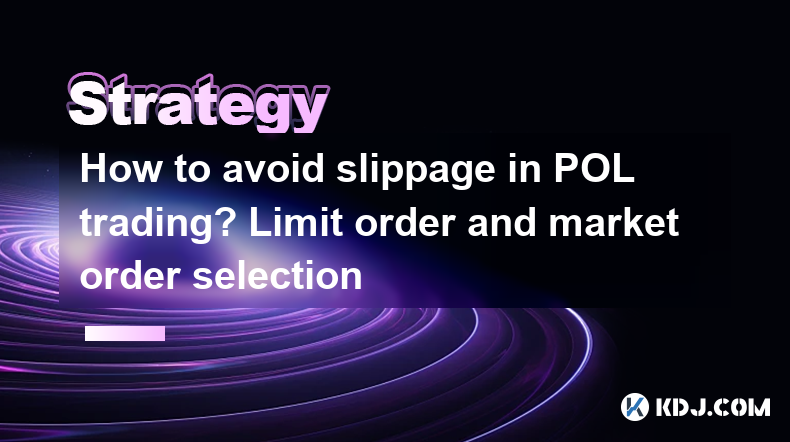-
 bitcoin
bitcoin $121833.232455 USD
-0.63% -
 ethereum
ethereum $4394.437030 USD
-2.00% -
 tether
tether $1.000570 USD
0.04% -
 bnb
bnb $1255.553465 USD
-3.73% -
 xrp
xrp $2.814944 USD
-1.59% -
 solana
solana $221.835346 USD
-2.40% -
 usd-coin
usd-coin $0.999869 USD
0.01% -
 dogecoin
dogecoin $0.249495 USD
-1.32% -
 tron
tron $0.336905 USD
-1.24% -
 cardano
cardano $0.816464 USD
-1.69% -
 chainlink
chainlink $22.130946 USD
-1.27% -
 hyperliquid
hyperliquid $44.208522 USD
-3.46% -
 ethena-usde
ethena-usde $1.000521 USD
0.02% -
 sui
sui $3.422897 USD
-2.51% -
 stellar
stellar $0.380164 USD
-1.31%
How to avoid slippage in POL trading? Limit order and market order selection
To minimize slippage in POL trading, use limit orders to set specific prices and trade during high liquidity periods; market orders can lead to higher slippage.
May 05, 2025 at 07:36 am

When trading cryptocurrencies like POL, slippage is a common concern that traders need to manage effectively. Slippage occurs when there is a difference between the expected price of a trade and the actual price at which the trade is executed. This can happen in fast-moving markets or when there is low liquidity. To minimize slippage, understanding the difference between limit orders and market orders is crucial. This article will delve into how to avoid slippage in POL trading by selecting the appropriate order type.
Understanding Slippage in POL Trading
Slippage in the context of POL trading refers to the difference between the price at which a trader expects to execute a trade and the actual price at which the trade is executed. This discrepancy can occur due to several factors, including market volatility, low liquidity, and the speed of the trading platform. For instance, if you place an order to buy POL at a specific price, but the market moves before your order is filled, you might end up buying at a higher price than intended.
The Role of Market Orders in POL Trading
Market orders are instructions to buy or sell POL at the best available current price. They are executed immediately, which can be advantageous in fast-moving markets where securing a position quickly is more important than the exact price. However, market orders are more susceptible to slippage because they are filled at the next available price, which can differ significantly from the last traded price.
- To place a market order for POL:
- Log into your trading platform.
- Navigate to the POL trading pair.
- Select 'Market Order' from the order type options.
- Enter the amount of POL you wish to buy or sell.
- Review the order details and confirm the trade.
Using Limit Orders to Minimize Slippage
Limit orders, on the other hand, allow traders to specify the price at which they are willing to buy or sell POL. These orders are only executed if the market reaches the specified price, which can help prevent slippage. However, there is a risk that the order may not be filled if the market does not reach the specified price.
- To place a limit order for POL:
- Access your trading platform.
- Go to the POL trading pair.
- Choose 'Limit Order' from the order types.
- Input the price at which you want to buy or sell POL.
- Enter the quantity of POL for the order.
- Double-check the order details and submit the order.
Strategies to Avoid Slippage in POL Trading
To effectively avoid slippage in POL trading, traders can employ several strategies that leverage both market and limit orders. Here are some key approaches:
Timing Your Trades
Timing your trades can significantly impact the amount of slippage you experience. Trading during periods of high liquidity, such as major market hours, can reduce the likelihood of large price gaps between orders.
- Monitor market hours and trading volumes for POL.
- Aim to place your trades when liquidity is high to minimize slippage.
Setting Appropriate Price Levels
When using limit orders, setting appropriate price levels is essential. These levels should be realistic and based on current market conditions to increase the likelihood of the order being filled without excessive slippage.
- Analyze the current POL price chart and market trends.
- Set your limit order price slightly above the current market price for buying, or slightly below for selling, to account for minor fluctuations.
Utilizing Stop-Limit Orders
Stop-limit orders combine the features of stop orders and limit orders, providing a more nuanced approach to managing slippage. A stop-limit order becomes a limit order once the stop price is reached, allowing you to control the price at which your order is executed.
- To set a stop-limit order for POL:
- Open your trading platform.
- Select the POL trading pair.
- Choose 'Stop-Limit Order' from the order types.
- Set the stop price and the limit price.
- Enter the quantity of POL for the order.
- Review and submit the order.
Monitoring and Adjusting Orders
Monitoring and adjusting your orders is crucial for managing slippage effectively. Market conditions can change rapidly, and being proactive in adjusting your orders can help mitigate potential slippage.
- Regularly check the status of your open orders.
- Adjust the price levels of your limit orders if the market moves significantly.
- Cancel and replace orders if necessary to adapt to new market conditions.
Choosing the Right Order Type for Your POL Trading Strategy
The choice between market orders and limit orders depends on your trading strategy and risk tolerance. Market orders are suitable for traders who prioritize speed and are willing to accept potential slippage. Limit orders are better for traders who want to control the price at which they buy or sell POL and are willing to wait for the market to reach their specified price.
- Evaluate your trading goals and risk tolerance.
- Decide if speed or price control is more important for your specific trade.
- Choose the order type that aligns with your strategy.
Frequently Asked Questions
Q: Can slippage be completely eliminated in POL trading?A: No, slippage cannot be completely eliminated due to the inherent volatility and liquidity issues in cryptocurrency markets. However, using the strategies outlined above can significantly reduce its impact.
Q: How does trading volume affect slippage in POL trading?A: Higher trading volumes generally lead to better liquidity, which can reduce slippage. When trading volumes are low, the spread between buy and sell orders can be wider, increasing the likelihood of slippage.
Q: Are there any tools or platforms that can help minimize slippage in POL trading?A: Some advanced trading platforms offer features like order book visibility and real-time market data, which can help traders make more informed decisions to minimize slippage. Additionally, algorithmic trading tools can execute trades at optimal times to reduce slippage.
Q: How does the size of the order affect slippage in POL trading?A: Larger orders are more likely to experience slippage because they may not be filled entirely at the desired price, especially in markets with low liquidity. Breaking large orders into smaller ones can help mitigate this risk.
Disclaimer:info@kdj.com
The information provided is not trading advice. kdj.com does not assume any responsibility for any investments made based on the information provided in this article. Cryptocurrencies are highly volatile and it is highly recommended that you invest with caution after thorough research!
If you believe that the content used on this website infringes your copyright, please contact us immediately (info@kdj.com) and we will delete it promptly.
- TT Jagannathan: The Prestige Founder Who Revolutionized Indian Kitchens
- 2025-10-10 12:25:15
- Bitcoin's Open Interest Dip: What's the Deal?
- 2025-10-10 12:25:15
- Dogecoin, Litecoin, and BlockDAG: Crypto's Old Guard Meets the New Kid
- 2025-10-10 12:30:02
- MOBU BTC: Why MoonBull Could Be Your Next Crypto Obsession
- 2025-10-10 12:45:14
- Coinbase, Staking, and the Crypto Scene: A New York State of Mind
- 2025-10-10 12:30:02
- Chainlink, Reserve, LINK Price: Decoding the Signals
- 2025-10-10 10:45:14
Related knowledge

Practical parameter settings for a Bitcoin multi-timeframe moving average system
Sep 18,2025 at 10:54pm
Optimizing Timeframe Combinations for Bitcoin Trading1. Selecting appropriate timeframes is crucial when building a multi-timeframe moving average sys...

How can I filter out false breakouts in Dogecoin high-frequency trading?
Sep 22,2025 at 01:00am
Understanding False Breakouts in Dogecoin Trading1. A false breakout occurs when Dogecoin's price appears to move beyond a defined support or resistan...

Techniques for identifying tops and bottoms in the Bitcoin on-chain NVT model
Sep 20,2025 at 07:54pm
Understanding the NVT Model in Bitcoin Analysis1. The Network Value to Transactions (NVT) ratio is often described as the 'P/E ratio' of the cryptocur...

What does the surge in open interest in Bitcoincoin futures mean?
Sep 20,2025 at 11:18pm
Understanding the Surge in Dogecoin Futures Open Interest1. A surge in open interest within Dogecoin futures indicates a growing number of active cont...

How can I use the Ethereum USDT premium to gauge market sentiment?
Sep 18,2025 at 11:55pm
Understanding the Ethereum USDT Premium1. The Ethereum USDT premium refers to the price difference between USDT (Tether) traded on Ethereum-based plat...

What should I do if Ethereum staking yields decline?
Sep 20,2025 at 06:18am
Understanding the Causes Behind Declining Ethereum Staking Yields1. The Ethereum network transitioned to a proof-of-stake consensus mechanism with the...

Practical parameter settings for a Bitcoin multi-timeframe moving average system
Sep 18,2025 at 10:54pm
Optimizing Timeframe Combinations for Bitcoin Trading1. Selecting appropriate timeframes is crucial when building a multi-timeframe moving average sys...

How can I filter out false breakouts in Dogecoin high-frequency trading?
Sep 22,2025 at 01:00am
Understanding False Breakouts in Dogecoin Trading1. A false breakout occurs when Dogecoin's price appears to move beyond a defined support or resistan...

Techniques for identifying tops and bottoms in the Bitcoin on-chain NVT model
Sep 20,2025 at 07:54pm
Understanding the NVT Model in Bitcoin Analysis1. The Network Value to Transactions (NVT) ratio is often described as the 'P/E ratio' of the cryptocur...

What does the surge in open interest in Bitcoincoin futures mean?
Sep 20,2025 at 11:18pm
Understanding the Surge in Dogecoin Futures Open Interest1. A surge in open interest within Dogecoin futures indicates a growing number of active cont...

How can I use the Ethereum USDT premium to gauge market sentiment?
Sep 18,2025 at 11:55pm
Understanding the Ethereum USDT Premium1. The Ethereum USDT premium refers to the price difference between USDT (Tether) traded on Ethereum-based plat...

What should I do if Ethereum staking yields decline?
Sep 20,2025 at 06:18am
Understanding the Causes Behind Declining Ethereum Staking Yields1. The Ethereum network transitioned to a proof-of-stake consensus mechanism with the...
See all articles

























![Web3 Crypto Market Morning Report: Fomo on the Bnb chain continues, Binance launches the chain-sweeping platform Meme Rush, the market value of Xiuxian exceeds 40 million U.S. dollars, OK Binance business war begins [Vic TALK Issue 1437] Web3 Crypto Market Morning Report: Fomo on the Bnb chain continues, Binance launches the chain-sweeping platform Meme Rush, the market value of Xiuxian exceeds 40 million U.S. dollars, OK Binance business war begins [Vic TALK Issue 1437]](/uploads/2025/10/10/cryptocurrencies-news/videos/web-crypto-market-morning-report-fomo-bnb-chain-continues-binance-launches-chainsweeping-platform-meme-rush-market-xiuxian-exceeds-dollars-binance-business-war-vic-talk-issue/68e861c5dbd1c_image_500_375.webp)
















































